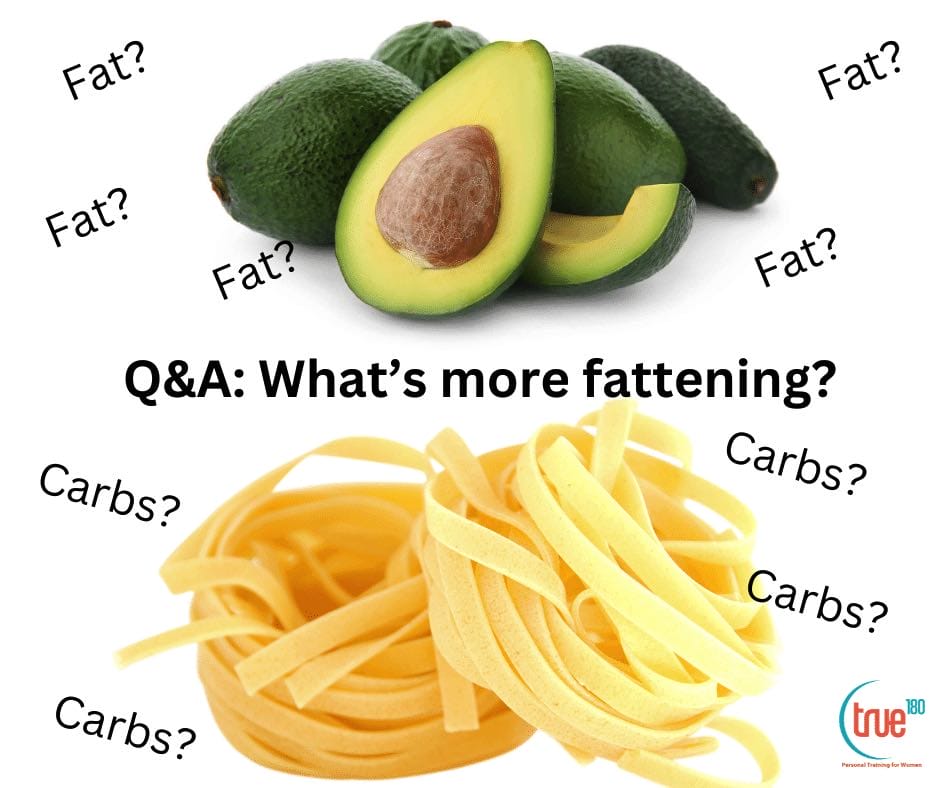I get this question all the time from clients wanting to lose fat or eat healthier.
Q & A: What’s more fattening? Fat or carbs?
A: Neither “a” or “b” above, It’s option “c” for calories… and, also, today is bonus answer day, so I am going to give you a second, seemingly contradictory answer: fat is more fattening than carbs.
Fat is more fattening?
Weight loss is calories in vs calories out, and fat loss is fat oxidation (fat burned) minus fat consumed. Excess food will eventually be stored in your body.
There are only 3 sources of calories: fat, carbs and protein. Consumed in excess, these will all get stored somehow, but fat is the easiest and most efficient to store as fat. It takes the least amount of work to convert fat into fat because there is no conversion necessary*.
TEF stands for thermic effect of food, or the amount of energy required to digest and/or store a food. (A popular clickbait scam is to tell people there are “negative calorie foods,” which is bullshit.) For fat the TEF is 0-5%, carbs are 5-10%, and protein is 20-30%. This means that 100 calories of protein would use up 30 calories in digestion, and would net you 70 calories.
Additionally, your body likes to keep carbohydrates around. This storage form of carbohydrate is called glycogen, and your body will try to keep about 500 grams of carbohydrates on hand. If you lift weights and get your steps in you are making room in your body for carbs to be stored as carbs not fat. Yes, if you have eaten too many calories, and you haven’t moved today, then your body will be converting some of your excess carbs into fat, but not all.
Fat, on the other hand, doesn’t have an alternative (non-fat), storage form like carbohydrates do. Fat is stored as fat, and that is that. (Rhyming like the cat in the hat. What do you think about that? To the article I should get back…)
Carbs, in excess, have some place to go in your body that doesn’t require them to be stored as fat. This requires physical activity, but physical activity is a good thing. Fat can only be stored as fat no matter how active you are.
*Fats are long strings of C-C-C-C-C-C… with some H’s on the side, and carbohydrates are rings of C’s, O’s and H’s, and the rings need to be broken apart, the O’s moved along, and then the remaining C’s have to be made into long strings. Not to get too deep into biochemistry, but that represents a lot of work your body needs to do – calories it needs to expend – in order to convert those carbs into fat.
What’s in a French Fry?
My favorite zen koan** is, “is a French Fry a fat or a carb?” Currently people would answer “carb,” and 40 years ago people would say “fat.” Who’s right? This leads to satori (zen for “sudden enlightenment”) where you embrace the duality of the situation of the fry, which is that French fries are both.
The secret of all super-delicious, can’t stop eating, hyperpalatable foods is that they’re packed with both fat and carbs. And not or. Cookies, cakes, croissants, buttery toast are high fat and high carb. Remove either part and they’re just not that good anymore, which does help you eat less, but won’t impress the in-laws.
365 calories for a “medium” French 
Carbs: 48g x 4 = 192 (52% calories from carbs)
Fat: 17g x 9 = 153 (42% calories from fat)
488 calories for a good sized chocolate chip cookie
Carbs: 58g x 4 = 232 (47% calories from carbs)
Fat: 28g x 9 = 252 (52% calories from fat)
**this is like “if a try falls in the woods an nobody is there to hear it, does it make a sound?” These questions are designed to promote doubt and detachment from our thoughts and opinions in order to help one reach satori or sudden enlightenment. All of this is, obviously, relevant.
Fat is sneaky
Fat is dense. Meaning that it packs many calories into a very small space. A standard serving of peanut butter is 2 tablespoons weighs 32 grams, and packs 198 calories. When I eat a spoonful of PB it’s always 5 (490 calories per spoonful), and I rarely stop at one… that’s a pretty big snaccident right? By contrast, 2 medium apples weigh 362 grams (more than 10x the PB), and pack fewer calories. Eating 2 whole apples takes work… I have never, ever eaten 5 on a whim… maybe on a bet, but never on a whim.
Let is be known, there is no upper limit on how fatty something can be and still taste yummy. Have you ever had 10% fat yogurt? Don’t do it! It is amazing, and it makes my fat-free Greek yogurt taste like shit for a week afterwards. Full fat yogurt is only 5%, and doubling the fat content just makes it yummier.
Whereas, let’s go back to our French 
So, next time you are trying to lose body fat or trying to decide what a healthier option is of something, focus on cutting back on your fat because it will have the biggest positive impact.
Your fat-free yogurt loving (liking?) coach,
Josef

